It looks like you're using an Ad Blocker.
Please white-list or disable AboveTopSecret.com in your ad-blocking tool.
Thank you.
Some features of ATS will be disabled while you continue to use an ad-blocker.
share:
I have this app on my iPad called exoplanets, which updates with the latest list of planets discovered by Kepler. Today it updated and i was surprised
to see the lastest list. It has nearly half a dozen of planets in the list most of them comparable to earths size and gravity and inside the habitable
zone of the star it orbits. I was so excited to see so many, so i did a quick google check to double check on them but no other info is yet available
on the net. So i will list the planets here for all:
Kepler 49b/c 1.06 times earth gravity
Kepler 51b/c 1.12 times earth gravity
Kepler 52b/c 1.05 times earth gravity
Kepler 53c 1.07 times earth gravity
Kepler 54b/c 1.05 times earth gravity
Kepler 55b 1.05 times earth gravity
Kepler 56b 1.08 times earth gravity
All the info above is based on what the app shows. All the above planets orbits inside the habitable zone as per the app.
I hope someone with more knowledge can confirm the latest release.
Once more info is available i will update this thread.
Regards
Kepler 49b/c 1.06 times earth gravity
Kepler 51b/c 1.12 times earth gravity
Kepler 52b/c 1.05 times earth gravity
Kepler 53c 1.07 times earth gravity
Kepler 54b/c 1.05 times earth gravity
Kepler 55b 1.05 times earth gravity
Kepler 56b 1.08 times earth gravity
All the info above is based on what the app shows. All the above planets orbits inside the habitable zone as per the app.
I hope someone with more knowledge can confirm the latest release.
Once more info is available i will update this thread.
Regards
edit on 20/8/12 by asen_y2k because: (no reason given)
reply to post by asen_y2k
The Mikulski Archive is the place to go if you really want to check Kepler data or any other space telescope.
The Mikulski Archive is the place to go if you really want to check Kepler data or any other space telescope.
reply to post by iforget
Thanks for the link. I had checked it out before i posted here. No planets after kepler 33 has been posted there. Its the february update there. There is a August update, which i am not sure has been publicly released or not. I am guessing the update on the app today i saw is the August update.
Thanks for the link. I had checked it out before i posted here. No planets after kepler 33 has been posted there. Its the february update there. There is a August update, which i am not sure has been publicly released or not. I am guessing the update on the app today i saw is the August update.
reply to post by iforget
Very nice. Though it is the "evil" NASA drones....
Bookmarked for future reference.
Very nice. Though it is the "evil" NASA drones....
Bookmarked for future reference.
reply to post by asen_y2k
It would seem to bode well for the likelihood of life out there, doesn't it?
Lots and lots of planets, and in such a small swath of sky...
It would seem to bode well for the likelihood of life out there, doesn't it?
Lots and lots of planets, and in such a small swath of sky...
reply to post by seagull
The first thought i had was, oh so now i know how in Star Trek the people always find a M class planet to crash land on, nearby! It seems like they are everywhere.
BTW most of these planets are thousands of light years away. But the telescope has been pointing in that direction. Actually the planets are close to each other in comparison to us. That means the possibility of habitable planets in this and other galaxy is high. Sure all habitable planets does not hold life(well most probably ) but its amazing how many there are.
The first thought i had was, oh so now i know how in Star Trek the people always find a M class planet to crash land on, nearby! It seems like they are everywhere.
BTW most of these planets are thousands of light years away. But the telescope has been pointing in that direction. Actually the planets are close to each other in comparison to us. That means the possibility of habitable planets in this and other galaxy is high. Sure all habitable planets does not hold life(well most probably ) but its amazing how many there are.
We've not even scratched the surface yet on how many planets we will find.
By that I don't just mean the number of planets in total but more so the number of planets around individual stars.
Look at the data from Kepler and other sources, most of the planets found have orbital periods far shorter than Mercury, many of them less than 10 days meaning they are unbelievably close to their host star.
These are the vast majority of planets being found at present simply because they pass in front of their host star many times in one "Earth Year" so the telltale signature of the stars light "dipping" can be spotted easier.
But what about planets with orbits of many Earth years? Neptune for example has not even completed one orbit around the sun since it's discovery, if we were looking back at our own solar system from another star we'd never spot Neptune yet as it would need to at least pass in front of the sun twice so that the data can be confirmed. planets with long orbits like Jupiter, Saturn, Uranus & Neptune are going to take a lot longer to be discovered because they will pass in front of their own star "relative to us" maybe only once a decade or longer, much longer in many cases. Then what about stars where the planetary ecliptic plane is "side on" to us? Planets orbiting these stars will never pass in front of the host star relative to us so we'll have to spot them using another technique.
Only when we have the ability to easily discover planets directly without the need to see a dip in the host stars light will we really get a picture of how common planets are around stars.
Kepler 11 is already up to letter "g" meaning the system has 6 confirmed planets (b,c,d,e,f,g), I personally believe we will discover that our Solar System of 8 known planets will be the norm or below average for the number of planets in a single system, if Kepler 11 already has 6 how many more are on long orbits so have not been found yet?
I am so excited about planet hunting because we are living in a time when "in my opinion" it is already showing us how "normal" our solar system is and that planets orbiting stars is common and this will lead to us answering the question of whether or not we are alone in the universe once and for all. When that time comes I cannot wait to tell a few people "I told you so".
By that I don't just mean the number of planets in total but more so the number of planets around individual stars.
Look at the data from Kepler and other sources, most of the planets found have orbital periods far shorter than Mercury, many of them less than 10 days meaning they are unbelievably close to their host star.
These are the vast majority of planets being found at present simply because they pass in front of their host star many times in one "Earth Year" so the telltale signature of the stars light "dipping" can be spotted easier.
But what about planets with orbits of many Earth years? Neptune for example has not even completed one orbit around the sun since it's discovery, if we were looking back at our own solar system from another star we'd never spot Neptune yet as it would need to at least pass in front of the sun twice so that the data can be confirmed. planets with long orbits like Jupiter, Saturn, Uranus & Neptune are going to take a lot longer to be discovered because they will pass in front of their own star "relative to us" maybe only once a decade or longer, much longer in many cases. Then what about stars where the planetary ecliptic plane is "side on" to us? Planets orbiting these stars will never pass in front of the host star relative to us so we'll have to spot them using another technique.
Only when we have the ability to easily discover planets directly without the need to see a dip in the host stars light will we really get a picture of how common planets are around stars.
Kepler 11 is already up to letter "g" meaning the system has 6 confirmed planets (b,c,d,e,f,g), I personally believe we will discover that our Solar System of 8 known planets will be the norm or below average for the number of planets in a single system, if Kepler 11 already has 6 how many more are on long orbits so have not been found yet?
I am so excited about planet hunting because we are living in a time when "in my opinion" it is already showing us how "normal" our solar system is and that planets orbiting stars is common and this will lead to us answering the question of whether or not we are alone in the universe once and for all. When that time comes I cannot wait to tell a few people "I told you so".
Here are the latest photos of their orbits. The diagrams consists of the planets orbit. They also show the relative orbits of inner solar system
planets eg mercury venus earth mars. The bright portion around the central star is the habitable zone where the planets can have a climate like
ours.
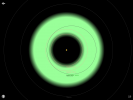
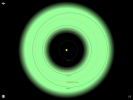

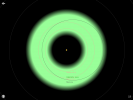
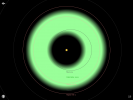
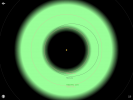
Please note my first posts is not so accurate in the light of these new diagrams. For eg. Kepler 51b/c can be considered 51c. This is because I did not have individual planet orbits. It was all mixed up as one planet.






Please note my first posts is not so accurate in the light of these new diagrams. For eg. Kepler 51b/c can be considered 51c. This is because I did not have individual planet orbits. It was all mixed up as one planet.
edit on 21/8/12 by asen_y2k because: (no reason given)
Kepler 49c-Smack inside the habitable zone.
Kepler 51c-Smack in the middle of the habitable zone(much like Earth)
Both Kepler 52b and 51c inside the habitable zone.
Kepler 54c smack in the middle of the habitable zone, with Kepler 54b also inside the habitable zone.
Kepler 55b also inside the habitable zone.
Kepler 56c also smack inside the middle of the habitable zone!
SO MANY planets discovered inside the habitable zone with some stars having multiple habitable zone planets. Its amazing! Last year just one planet Kepler 22b made such a big uproar, this year we have more than half a dozen of them!
Total=8 Planets!
Kepler 51c-Smack in the middle of the habitable zone(much like Earth)
Both Kepler 52b and 51c inside the habitable zone.
Kepler 54c smack in the middle of the habitable zone, with Kepler 54b also inside the habitable zone.
Kepler 55b also inside the habitable zone.
Kepler 56c also smack inside the middle of the habitable zone!
SO MANY planets discovered inside the habitable zone with some stars having multiple habitable zone planets. Its amazing! Last year just one planet Kepler 22b made such a big uproar, this year we have more than half a dozen of them!
Total=8 Planets!
edit on 21/8/12 by asen_y2k because: (no reason given)
reply to post by asen_y2k
I found the source link. Nice post dude thanks alot i'm off to read the paper
I found the source link. Nice post dude thanks alot i'm off to read the paper
edit on 21-8-2012 by yeti101 because: (no reason given)
reply to post by yeti101
Here are the details:
Kepler 49- 0.55 solar mass/0.53 solar radius.
Kepler 51-1 solar mass/0.91 solar radius
Kepler 52-0.54 solar mass/0.52 solar radius
Kepler 54-0.51 solar mass/0.50 solar radius
Kepler 55-0.62 solar mass/0.58 solar radius
Kepler 56-0.62 solar mass/0.58 solar radius
Oh and more about the app(I am sorry, I should have given out this info earlier):
App-Exoplanet by Hanno Rein (Professional astromer)
Site: exoplanet.hanno-rein.de...
Database is sourced from: exoplanet.eu... , exoplanets.org... , simbad.u-strasbg.fr...
Here are the details:
Kepler 49- 0.55 solar mass/0.53 solar radius.
Kepler 51-1 solar mass/0.91 solar radius
Kepler 52-0.54 solar mass/0.52 solar radius
Kepler 54-0.51 solar mass/0.50 solar radius
Kepler 55-0.62 solar mass/0.58 solar radius
Kepler 56-0.62 solar mass/0.58 solar radius
Oh and more about the app(I am sorry, I should have given out this info earlier):
App-Exoplanet by Hanno Rein (Professional astromer)
Site: exoplanet.hanno-rein.de...
Database is sourced from: exoplanet.eu... , exoplanets.org... , simbad.u-strasbg.fr...
edit on 21/8/12 by asen_y2k
because: (no reason given)
in the paper it says kepler 51c is 5.71 earth radius unless i'm reading it wrong?
edit on 21-8-2012 by yeti101 because: (no reason
given)
reply to post by yeti101
Your link is not working, could you please check it. Eagerly waiting to read some more
Your link is not working, could you please check it. Eagerly waiting to read some more
edit on 21/8/12 by asen_y2k because: (no reason
given)
Originally posted by yeti101
in the paper it says kepler 51c is 5.71 earth radiusedit on 21-8-2012 by yeti101 because: (no reason given)
Yea with nearly Earth gravity, must be low density.
Originally posted by yeti101
in the paper it says kepler 51c is 5.71 earth radius unless i'm reading it wrong?edit on 21-8-2012 by yeti101 because: (no reason given)
But K-54c is smack in the middle of the habitable zone with 1.5 earth mass/1.23 earth radius and 1.01g, Perfect! Very similar to earth.
edit on 21/8/12 by asen_y2k because: (no reason given)
reply to post by asen_y2k
yeah but its an M star . still be interesting to find out what its really like.
yeah but its an M star . still be interesting to find out what its really like.
reply to post by yeti101
Well, does not matter much right? If the planet is getting the same amount of heat as we are getting from our Sol? It can still have a comparable climate, but not a differentiated weather as us because it has an orbital period of a few days. Hope its not tidally locked.
Well, does not matter much right? If the planet is getting the same amount of heat as we are getting from our Sol? It can still have a comparable climate, but not a differentiated weather as us because it has an orbital period of a few days. Hope its not tidally locked.
reply to post by asen_y2k
it probably will be tidally locked. M stars seem to be problematic for earth like planets for various reasons.
en.wikipedia.org...
even bigger ones still face most of the same problems.
it probably will be tidally locked. M stars seem to be problematic for earth like planets for various reasons.
As of 2012, many factors appear to indicate that many red dwarfs, smaller than 30% of Sun's mass, have a very low probability for hosting indigenous life.
en.wikipedia.org...
even bigger ones still face most of the same problems.
edit on 21-8-2012 by yeti101 because: (no reason given)
reply to post by yeti101
But sadly most of the stars in the sky infact 90% are these types. If not the planet the moons could certainly support life. And these stars burn for tirrilions of years, much longer than our sol. This means life has more time to evolve there. Just imagine the types of life we can find there.
But sadly most of the stars in the sky infact 90% are these types. If not the planet the moons could certainly support life. And these stars burn for tirrilions of years, much longer than our sol. This means life has more time to evolve there. Just imagine the types of life we can find there.
new topics
top topics
-
Federal law trumps state and local law every time
Social Issues and Civil Unrest: 17 hours ago, 17 flags
active topics
-
Petition Calling for General Election at 564,016 and rising Fast
Political Issues • 94 • : Freeborn -
-@TH3WH17ERABB17- -Q- ---TIME TO SHOW THE WORLD--- -Part- --44--
Dissecting Disinformation • 3384 • : brewtiger123 -
BIDEN Admin Begins Planning For January 2025 Transition to a New President - Today is 4.26.2024.
2024 Elections • 59 • : WeMustCare -
DOJ Special Counsel Robert HUR Says JOE BIDEN Can Be ARRESTED After Jan 20th 2025.
Above Politics • 30 • : WeMustCare -
On Nov. 5th 2024 - AMERICANS Prevented the Complete Destruction of America from Within.
2024 Elections • 160 • : WeMustCare -
Results of the use of the Oreshnik missile system in Dnepropetrovsk
World War Three • 240 • : 777Vader -
Both KAMALA and OBAMA are on the Nov 5th 2024 Ballot - If One Loses - Both Lose.
2024 Elections • 9 • : WeMustCare -
How many people, in GENERAL, are musically inclined?
Music • 26 • : Huronyx -
Well, here we go red lines crossed Biden gives the go ahead to use long range missiles
World War Three • 395 • : annonentity -
Federal law trumps state and local law every time
Social Issues and Civil Unrest • 30 • : ADVISOR
